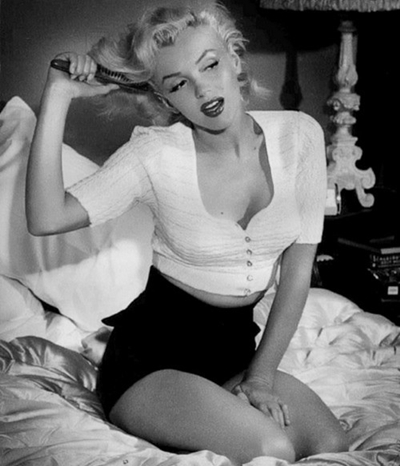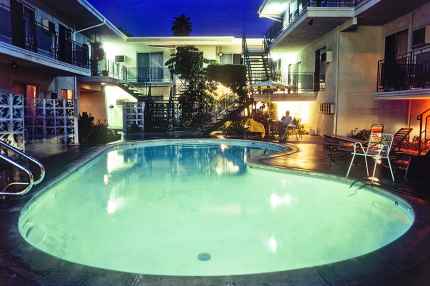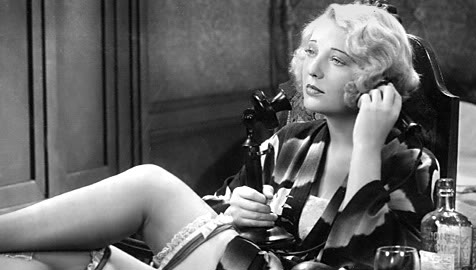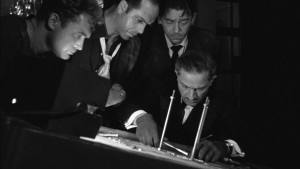Marilyn Monroe would have been 89 today. We are re-running this essay as a tribute to our favorite blonde bombshell.

Marilyn Monroe (June 1, 1926-Aug. 5, 1962) will be honored at a memorial service on Monday, Aug. 5, in Westwood.
Bugs. Dogs. God. Since childhood, she was quick to ask questions about the everyday and the esoteric. This little girl named Norma Jean, as curious and proud as she was lonely and neglected, grew up to be Marilyn Monroe, the world’s most iconic and enduring sex symbol. Her love affair with the public still burns bright more than 50 years after her death on Aug. 5, 1962. She was 36.
Perhaps she sought answers and collected facts as a distraction from the grinding poverty and desperate uncertainty she faced as a kid. Her mother, Gladys, who fought bouts of mental illness, was unable to take care of her and her father had long been absent from their lives.
Norma Jean bounced between friends’ places and foster homes in Los Angeles. She was treated poorly for the most part, made to bathe in dirty water, molested by a man named Mr. Kimmel, pushed into marriage at 16 to Jim Dougherty, whom she barely knew, to avoid returning to the orphanage.
She was physically as well as intellectually precocious, fully developed by 12, and she knew her looks would open doors for her. There was a way, she believed, she could parlay her games of make believe into something refined, meaningful and artistic. If she got training and made the right connections, she could escape from her harrowing childhood.

“The truth was that with all my lipstick and mascara and precocious curves, I was as unsensual as a fossil. But I seemed to affect people quite otherwise.” — MM on her school days

“After a few months, I learned how to reduce the boredom [at a Hollywood party] considerably. This was to arrive around two hours late.” — MM

“I could never be attracted to a man who had perfect teeth. I don’t know why, but I have always been attracted to men who wore glasses.” — MM
She got a few small parts in the pictures, studied acting and attended Hollywood parties, carefully crossing her legs to hide the holes in her nylons, quietly watching other guests play cards and win money.
“When the men laughed and pocketed the thousands of dollars of winnings as if they were made of tissue paper, I remembered my Aunt Grace and me waiting in line at the Holmes Bakery to buy a sackful of stale bread for a quarter to live on a whole week,” she recalled in her memoir (co-written with Ben Hecht), “My Story.”
The studio suits weren’t encouraging. Darryl Zanuck and Dore Schary told her that she was unphotogenic, that she didn’t have the right look. She persevered. Eventually, it was her enraptured fans (she garnered 7,000 letters a week) who fueled her fame and propelled her rise to the top. “I knew I belonged to the public and to the world, not because I was talented or even beautiful but because I had never belonged to anything or anyone else.”

“We were the prettiest tribe of panhandlers that ever overran a town.” — MM on her early years as a Hollywood actress.
One of her most important movies, early on, was a film noir: “The Asphalt Jungle” (1950, John Huston). “Don’t Bother to Knock” (1952, Roy Ward Baker) and “Niagara” (1953, Henry Hathaway) also showcased her talent for playing dark, dangerous women.
The studio pushed her toward lighter fare – musicals and comedies – where she played frothy flirts and bubble-headed gold diggers: “Gentlemen Prefer Blondes” (1953, Howard Hawks), “How to Marry a Millionaire” (1953, Jean Negulesco) and “There’s No Business Like Show Business” (1954, Walter Lang).
Marilyn pushed back, wanting more complex parts and sometimes she got them. She teamed up with some of Hollywood’s greatest directors: Huston, Hawks, Otto Preminger in “River of No Return” (1954), Joshua Logan in “Bus Stop” (1956), twice with Billy Wilder, in 1955’s “The Seven Year Itch” and four years later in the black-comedy classic “Some Like It Hot.”
In 1960, she worked with George Cukor in “Let’s Make Love.” Cukor also directed her in the unfinished “Something’s Got to Give” (1962). She co-starred with Sir Laurence Olivier (he also directed) in “The Prince and the Showgirl” (1957) and earned acclaim for her work, especially from European critics.

It was choreographer Jack Cole’s idea to pair pink and red in the color scheme of 1953’s “Gentlemen Prefer Blondes.”
Marilyn was the favorite movie actress of the French philosopher/novelist/playwright Jean-Paul Sartre, and he wrote the lead female part in his original script “Freud” (1962) for her. (Susannah York played it.)

“I’ve often stood silent at a party for hours listening to my movie idols turn into dull and little people.” — MM
Her boyfriends reportedly included Marlon Brando, Frank Sinatra, Elia Kazan, Orson Welles, Yves Montand, John F. Kennedy and Robert Kennedy; her best girlfriend (and one-time roommate) was Shelley Winters. During the height of her fame, Marilyn married two more times – to Yankee baseball great Joe DiMaggio (January-October 1954) and to playwright Arthur Miller (1956-1961).
Miller wrote “The Misfits” (1961) for her. In that ill-fated film, Marilyn co-starred with Clark Gable, the movie star she’d so often pretended was her father, and was directed by Huston, whom she considered a genius. During the arduous shoot in the Nevada desert, the Monroe-Miller marriage came apart. Gable died from a heart attack days after the filming ended. Said Huston of Marilyn: “She went right down into her own personal experience for everything, reached down and pulled something out of herself that was unique and extraordinary. She had no techniques. It was all the truth, it was only Marilyn.”
Her vulnerability and little-girl-lost quality, coupled with her stunning looks and glamour, are often cited as the reasons for her widespread, lasting appeal.
There’s no doubt she faced a litany of lingering problems: a family history of mental illness; emotional instability and physical maladies; a dependency on drugs and alcohol; endometriosis, abortions and miscarriages; difficulty remembering lines and showing up on time; broken marriages and failed affairs as well as frustration and fights with 20th Century-Fox (the studio refused to let her see scripts in advance of a shoot, then relented).
Some of her early work is slightly cloying – the breathy voice a little too mannered, her demeanor a little forced. And despite critical recognition for “Bus Stop,” “Prince” and “Some Like It Hot,” she remained pigeonholed as a blonde bombshell, a sexy joke.

“When you’re a failure in Hollywood – that’s like starving to death outside a banquet hall with the smells of filet mignon driving you crazy.” — MM

“When you’re broke and a nobody and a man tells you that you have the makings of a star, he becomes a genius in your eyes.” — MM

Marilyn’s marriage to playwright Arthur Miller came apart while making “The Misfits.” Co-star Clark Gable died days after shooting ended.
Yet it was her precise and subtle comic timing that set her apart from other actresses. As Wilder put it: “She was an absolute genius as a comic actress, with an extraordinary sense for comic dialogue. … Nobody else is in that orbit; everyone else is earthbound by comparison.”
Humor was likely a coping mechanism she’d honed in an effort to ward off the crushing emptiness she’d known since childhood. Norma Jean saw movies again and again at Hollywood theaters; play-acting with other kids, she thought up the good stuff, the drama.
Marilyn liked her body and, some days, she enjoyed the attention she got from her looks. But she also gave the impression that her beauty could be swiftly forgotten, that she got bored too fast to dwell on her appearance. Underneath the surface, right alongside the troubled soul, was a well of pure bliss that wasn’t hard to reach, if she had a receptive audience, whether it was a likeminded bookworm friend or a movie palace packed with people.
When the fantasy was in full, giddy swing, she laughed sweetly and cynically, sometimes at herself. She could be funny with a look, a gesture or a makeshift prop – sparking joy from nothing at all.
Photographers include: George Barris, Richard Avedon, Philippe Halsman, Milton Greene, Sam Shaw and Bert Stern.









































From FNB readers